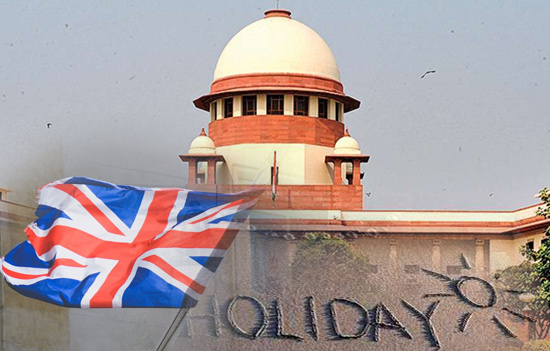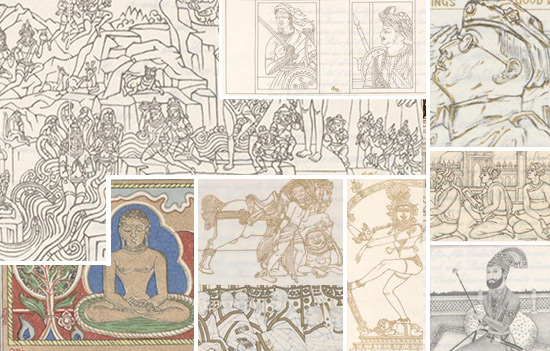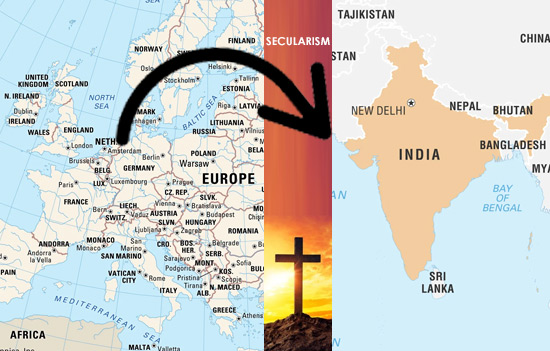- This article briefly shares six colonial
practices that the Higher Judiciary can choose to change.
President of India D Murmu said in the MINT, “Equal justice and getting rid of now redundant colonial practices should be the guiding principles of our judiciary. While continuing with usual aspects of pre-independence jurisprudence, we should remove the legacy burden.” November 2024.
This article tries to decipher what
decolonization of the Higher Judiciary means.
1. Black Coats
 Nehru Jackets
Nehru Jackets
“The Lawyers Act 1961 also made it mandatory for lawyers and judges to wear black coats and neckbands inside the court. This practice originated from England. Under the Act, wearing a black coat with a white band tie was made mandatory in the courts.” Source
Black coats work well in the climate of England not in India where it gets pretty hot and humid.
Can the black coats be replaced with Blue and Grey Nehru jackets and do away with the white band tie? If SC Judges start the trend, others might follow.
2. Vacation Policy

During British rule and when the maximum number of judges were British, they headed home for summer vacation being unable to bear Delhi’s heat. The tradition has continued in independent India.
Retired Judge of Bombay High Court V.G. Palshikar said, “All judges were English people, who had families in England. They would go there and come back by ship: one month to go, one month to stay with them, and one month to come back. Therefore you have three months of summer vacation; that was a necessity.” Source The Hindu
Can
leave rules for SC Judges be laid down? Propose 30 days annual leave, 10 days
casual leave and Medical Leave based on actual needs not to exceed a
pre-specified number of days.
Read Can
the Vacation Policy of the Supreme Court shed its Colonial Legacy
3. My Lord
Esamskriti author and specialist in Roman
Catholic theology, Dr Subhasis
Chattopadhyay writes on use of the word Lord, “If one reads the novel Bleak House by Charles Dickens, one sees how a fatigued judiciary is addressed in terms of feudal royalty. Unfortunately this colonial baggage is still to be found in our nation, since we have not been able to shed off the yoke and detritus of our erstwhile British masters. A sad analogy is provided by our outdated bureaucracy which is top heavy and informed by the same mindset which governs our judiciary --- vide The Men who Ruled India by Philip Mason. This is the, ‘my Lord and Ladies/ my baap/ sahib/janab- hoozor’ culture that flies against the very fabric of democracy where all of us are equal in the eyes of the law.”
Can it be replaced with Sri Judge Surname?
4. Lots of Acts date back
to the Colonial era
Parsis are governed by the Parsi
Marriage and Divorce Act 1936. Muslim women are governed by religion based laws
in matters of inheritance i.e. ‘The Muslim Personal Law (Shariat) Application Act, 1937’.
According to advocate Rajesh Gehani, “Shariyat or Shariah means Law governing Muslims. It is not codified. The provisions are often vague and undefined. Also, it lacks uniformity across numerous Islamic sects.”
Read Inheritance
Laws for Muslim Women
Can the Executive pass laws drafted in
post-Independent India? It is
over 70 years now. The above is by no means an exhaustive list.
5. Less acknowledging of Indian Heritage and Civilization

Mottos in
logos in government institutions clearly indicate that the founding fathers
were deeply rooted in Indian Heritage and Civilization. So also the
motto within the logos of the
above institutions, established during the 1950’s and 1960’s, were inspired from the Vedas, Upanishads and Puranas. The handcrafted Constitution also shared pictures of
Indian heritage and history.
So, in spite
of the majority of the makers of modern India being influenced by European
thoughts they probably adopted Western concepts because whilst drafting the
Constitution that was the only available precedent. This is borne out by the
first draft prepared in October 1947 that gave references to Western constitutions from where the clauses were
borrowed
Read Pictures
in the Handcrafted Constitution of India
Each part
of the Constitution had paintings that represent the Indian Civilization. How many honourable judges have referred refer
to this in the recent past? All we invariably hear is of colonial concepts.
6. Emphasis on Rights
rather than Dharma
During a 2013 interactive session with students of Vivekanand Kendra School Jirdin, at Aalo in Arunachal Pradesh one of the students asked why India’s political system was in disarray and the country in such a bad state.
I quoted Sri Aurobindo. “It has been said that democracy is based on the rights of man; it has been replied that it should rather take its stand on the duties of man; but both rights and duties are European ideas. Dharma is the Indian conception in which rights and duties loose the artificial antagonism created by a view of the world, which makes selfishness the root of action, and regain their deep and eternal unity. Dharma is the basis of democracy which Asia must recognize, for in this lies the distinction between the soul of Asia and the soul of Europe”.
When one demands something from another as a matter of right the demand is associated with ‘I’ and resultant ego. Conversely, the starting point to Dharma or duty is your willingness to serve others. The bhavna (feeling) is what
can I do for you; the intent is to find solutions and attitude is selfless
work. This leads to value addition, creation and contentment not negativity.
Dr Arghya Sengupta, Research Director at
Vidhi Centre for Legal Policy, wrote in The
Colonial Constitution that, “The notion of rights was a tradition dating back to the French Revolution: oppressed citizens demanding their rights as men and women equal before the law.” Pg 122.
We
need to move to a Dharma based approach. Having Dharma in the SC logo is not good enough.
India’s legal reforms should focus on cultural identity rather than religion which is a Middle East concept. For e.g. In the Sabarimala case the expression ‘Religious Denomination’ was used to determine whether Ayappa devotees, constituted a religious
denomination under Article 26, had freedom to manage their own affairs in
matters of religion. Article 26 is derived from the Irish/Polish constitutions.
How relevant are they to Bharat?
Can courts focus on
cultural identity alone rather than religion and religious discourses, which
are Abrahamic concepts?
Now let us look at some colonial
concepts that are endorsed by the courts.
7. Do you relate to the
Preamble of the Constitution?
The preamble reads, “WE, THE PEOPLE OF INDIA, having solemnly resolved to constitute India into a SOVERGEIN SOCIALIST SECULAR DEMOCRATIC REPUBLIC and to secure to all its citizens. JUSTICE, social, economic and political; LIBERTY of thought, expression, belief, faith and worship; EQUALITY of status and opportunity; and to promote among them all FRATERNITY assuring the dignity of the individual and unity and integrity of the Nation;
In a way the Supreme Court motto, Yato Dharmah Tato Jayah, Where there is
Righteousness (Dharma), there is Victory (Jaya),
has inspired me to suggest a new preamble.
The proposed preamble could start with “WE, THE PEOPLE OF INDIA, shall STRIVE to live by and follow - Dharma, Divinity, Samman, Sahayak, Daya, Swatantra Soch, Ekagrata, Deshbhakti and Anushashan.”
Atleast Bharatiyas can understand it. It
also makes translation into Indian languages easier.
Read What could the Preamble of India’s Constitution be
8. Secularism ki jai hoo
 Secularism was exported from Europe to India.
Secularism was exported from Europe to India.
According to Why Nehru
dropped and Indira included the S-word in the Constitution
published by the Indian Express, “The word ‘secularism’ is known to have originated in late medieval Europe. “Secularism, the theory that governments ought to have no religious connection, nor indeed anything to do with matters of religious belief or ritual, is manifestly a Western intervention, specifically a product of the Protestant Reformation and the Enlightenment,” writes historian Ian Copland.”
The situation in India was different. Sanatan Dharma was neither governed by a monolith organisation, then or today, like the church nor did it own property and control the state.
Long before secularism entered
popular discourse, the followers of dharma (read as Hindus,
Buddhists, Jains and Sikhs) gave refuge to those who were persecuted in other countries for e.g. Parsis, Jews and a
body of Christian immigrants.
Courts
see majority rule in Muslim and Christian majority countries and think Indics
shall behave like that. It is a failure to understand Sanatana Dharma. I blame the education system, none other.
Read Comparing Indic vs. Abrahamic Faiths and Swami Vivekananda’s 1893 Chicago Address
Read What is Secularism and The Battle
between Secular India and Bharat and What India can
learn from Vidya Balan
9. Origin of Article 30
lies in the discussions held primarily in the Second Round Table Conference
held in 1931
Hariprasad and Sanjeev wrote, “The initial Draft versions of the Indian Constitution prepared by Dr K M Munshi had proposed explicit, and equal, educational rights to all communities. However, when this section was referred to the Minorities sub-committee of the Constituent Assembly, what came out was a very different version. It read:”
“All minorities, whether of religion, community or language, shall be free in any unit to establish and administer educational institutions of their choice, and they shall be entitled to State aid in the same manner and measure as is given to similar State-aided institutions.”
“The origin of Art 30 lies in the discussions held primarily in the Second Round Table Conference held in 1931. It was derived from the memorandum submitted by Indian Christian representatives then. The version of the clause in the memorandum actually asked for “equal rights for all religions”. However, in the joint agreement version, that particular phrase was left out.” End of quote.
10. Courts and Governments
keep referring to on Minorities. But the Indian constitution does not define
who is a minority.
The word is
alien to India. J Sai Deepak wrote in India that is Bharat, “Religious minorities in this context were denominational minorities from within the same religion, namely Christianity.” Pg. 93
Read Why
India must have no place for a religious minority
These are just a few examples how India
is being ruled and living in a way that is alien to its True Self.
India must follow its
Svadharma
Verse 35 (ch3) of the Holy Gita says it well “One’s own duty (svadharma), though deficient in quality, is superior to duty other than one’s own (paradharma), though well accomplished. Better it is to die in svadharma; paradharma is fraught with fear and danger’. Swami Chinmayanandaji explained ‘to act according to one’s own taste, inborn and natural, is the only known method of living in peace and joy, in success and satisfaction. It is dangerous to suppress his own personality-expression and copy the activities of someone else, even he be living a nobler and diviner life’.
Until governments and the
Indian people imbibe Indic concepts we shall fail to realize our potential and
be at peace with ourselves.
11. SC and ST
The term SC was first introduced around
the 1930s and ST around 1949. Ambedkar said he belonged to the Depressed
Classes, a term he coined. STs are called Vanvasis. And now we have Other Backward
Classes. Did you know that
A. Ace music director R B Burman was ST
from Tripura?
B. The former rulers of Tripura are
called ST using colonial concepts?
C. Numerous OBC
Kings of India for e.g. Raja Suhdev,
D. Ambedkar and Brahmins – his second wife was a Brahmin. The surname Ambedkar is actually that of Ambedkar’s Brahmin teacher who liked him very much. Read Ambedkar
and Brahmins
12. Decolinization of Higher
Judiciary is not Manusmriti?
Indic scholar Srinath Sharma wrote, “The
Vedas are known as Shruti because they are divine knowledge that were directly "heard" or "revealed" to ancient sages (Rishis) through deep meditation and spiritual insight. The Smritis were created to keep the essential knowledge
alive and to provide practical guidance on how to live ethically and
spiritually. There are numerous Smritis.
Although Smriti is derived from Shruti, which is the Vedas, it is not the case that the Smritis were followed by all and uniformly across India.” Read What
is the meaning of SHRUTI and SMRITI in Sanatan Dharma
In case I have missed out any symbols of
colonization please email me esamskriti108@gmail.com In case of any errors, happy to stand corrected. The purpose of this article is to provoke thought.
Also
read
1. Decolonization
of the Indian Legal System
2. Decolinising
the of the Indian Legal system through Transformational Constitutionalism
3. Who
were Scheduled Tribes
4. SC – review colonial laws interpretations
5. Justice
Bhat explores decolonization and Indianization of the Indian Legal System
6. Judicial
System of the Marathas
7. Human
Rights in Sanatana Dharma
8. What
is the meaning of SHRUTI and SMRITI in Sanatan Dharma